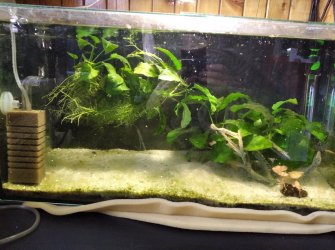Beastije
Fish Addict
Hi. So in my 54l tank, sand substrate, established, airfilter tank, i have 10 new sterbai corydoras.
There are anubias plants that work as shelter and shade, no other inhabitants except two snails, water change was done 6 hours before adding them, 50%.
I have few weeks before i need to use the tank again, so no hurry and since they are in good numbers i don't fear they will be stressed in the quarantine.
Are there any sure tips I should follow or should I treat this as any other tank with weekly water change and feeding them every day, even twice and one day break.
Should I do more often water changes, not turn on the light, feed more, feed less, preventive salt baths, anything that will increase the chances of them making it out alive and strong before joining the rest of my shoal?
We already discussed the food, fluval bug bites, dennerle shrimp king, frozen cyclops, Daphnia, bloodworms once a week max. No crap
Thanks
Edit: attaching a crappy quick pic i took before adding them, in case you wonder how the tank looks
There are anubias plants that work as shelter and shade, no other inhabitants except two snails, water change was done 6 hours before adding them, 50%.
I have few weeks before i need to use the tank again, so no hurry and since they are in good numbers i don't fear they will be stressed in the quarantine.
Are there any sure tips I should follow or should I treat this as any other tank with weekly water change and feeding them every day, even twice and one day break.
Should I do more often water changes, not turn on the light, feed more, feed less, preventive salt baths, anything that will increase the chances of them making it out alive and strong before joining the rest of my shoal?
We already discussed the food, fluval bug bites, dennerle shrimp king, frozen cyclops, Daphnia, bloodworms once a week max. No crap
Thanks
Edit: attaching a crappy quick pic i took before adding them, in case you wonder how the tank looks



